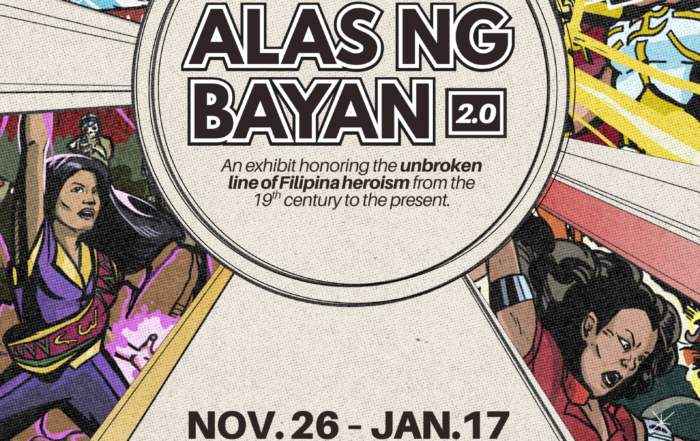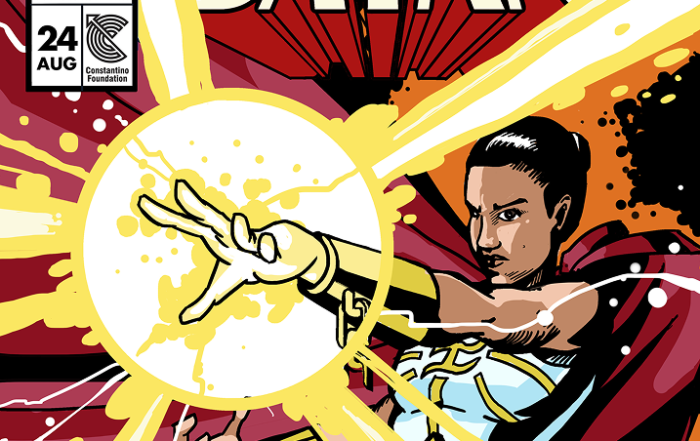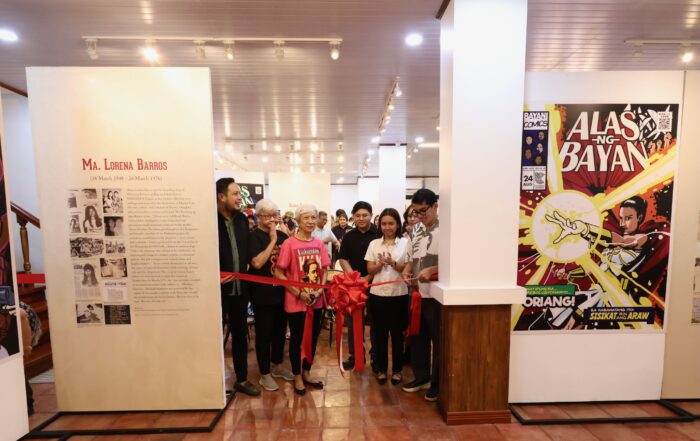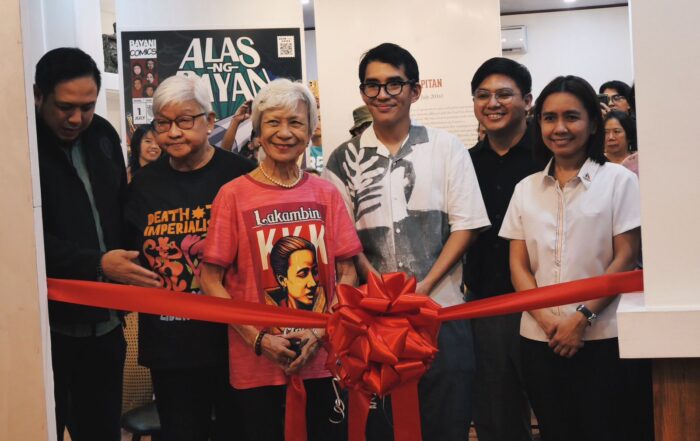Alas ng Bayan is a history-through-art initiative that seeks to introduce the Philippine past and feminism as fundamental elements in the way young people respond to the worsening state of national forgetting and the climate crisis. It intends to mobilize sectors not normally active in the climate debate by offering new notions of citizenship and nationalism responsive to the multiple emergencies we face today. Viewers of the paintings and those who participate in the lectures and workshops that accompany the exhibit encounter parallels between the lives of the women depicted and current topics under intense public debate, such as violence against women, LGBTQ+ rights, extrajudicial killings, global warming, and national sovereignty.
Alas ng Bayan generates awareness about the intersections between women, history, memory, climate change, and citizenship. The exhibit is composed of five paintings depicting individually the heroes Gregoria “Oriang” de Jesus, Apolonia Catra, Remedios “Kumander Liwayway” Gomez-Paraiso, Lorena Barros, and Gloria Capitan. Partner organizations, interested groups, and individuals are encouraged to add more women to the roster of heroes.
The project was launched at the Constantino Foundation’s Linangan Gallery in November 2019, considered the “heroes month” in the Philippines. The paintings toured several universities, namely University of the Philippines Diliman, the Polytechnic University of the Philippines, and De La Salle University. It concluded in March 2020, celebrated as international women’s month. The works are now back at the Linangan Gallery and a second exhibit is in the works, once more in collaboration with 350 Pilipinas.
ALAS NG BAYAN 2.0

Revealing the Superpowered
Rio Constantino – Exhibit Curator, Biologist, Batman-in-training
This is an exhibit about memory, as well as the responsibilities of those inheriting that memory, told using a visual language that should be familiar to most modern audiences.
During the pandemic, Billy Pangilinan and I worked on the idea of transforming Filipina heroines into superheroines. I speak as if we gave equal contributions to the project, but really all the art is by him. My main role was to provide creative feedback. That, and to connect our efforts with prior endeavors: the Alas ng Bayan paintings, commissioned and first exhibited at the Constantino Foundation’s Linangan Gallery in 2019.
The paintings depict five exemplary Filipinas from more than a century of history: the revolutionary Gregoria “Oriang” de Jesus (1875 – 1943); Apolonia Catra (d. 1905), the only named woman officer of the Katagalugan Republic, and a figure feared by American soldiers; Remedios Gomez-Paraiso (1918 – 2014), also known as “Kumander Liwayway”; Maria Lorena Barros (1948 – 1976), founding chair of the Malayang Kilusan ng Bagong Kababaihan, or MAKIBAKA; and Gloria Capitan (1959 – 2016), the first recorded extrajudicial killing under Duterte, who had resisted the construction of a coal plant and open coal storage facility in her hometown of Barangay Lucanin, Mariveles, Bataan.
The exhibit was a means of counteracting the twin ills of climate change and national forgetting. It was also a way to help reverse the belittling which women have too often struggled against throughout history. Both were goals which Billy readily contributed his talents to.
All five Alas women led remarkable lives fighting injustice and oppression. All became intensely involved addressing matters that are still keenly felt today, such as global warming, LGBTQ+ rights, police impunity, and national sovereignty. (Some visitors may wonder what Oriang or Catra, living during the late 19th to early 20th centuries, had to do with the catastrophes imposed by fossil fuels. Remember, the steamships that brought colonial troops to the Philippines were powered by coal.)
But whereas the original paintings used the esoteric symbolism of tarot cards to explore the histories of Oriang and her peers, Billy drew on another font of inspiration for this second iteration of Alas ng Bayan: that of comics, also known as komiks, or in other regions as manga or manhwa.
The choice came naturally to us, being avid followers of anything involving science fiction or fantasy. Billy is a fan of DC and Marvel, meaning Superman, Wonder Woman, Iron Man, the X-Men. Both of us have read, and enjoyed, The Mythology Class by Arnold Arre. Then of course there’s the universal shōnen trifecta of Naruto, Bleach, and One Piece; as a high school student I also secretly read (because my teenage insecurity wouldn’t let it be known) the manga titled Maid Sama! More recently there’s been Dead Balagtas by Emiliana Kampilan, as well as Ella Arcangel by Julius Villanueva and Mervin Malonzo.
People of all ages still read comics today, because comics have power. They, like other forms of storytelling, serve as potent channels for learning and communion. What better way to convey social and ecological degradation than the diwata queen encountered by Ella Arcangel on a city street, the fairytale creature reduced by years of decay until its form resembled little more than an insectile husk? Similarly, what more eloquent manner of teaching the ethos required to escape our current crisis, than Ella herself humbly approaching a god of the earth, asking for its permission, on her community’s behalf, to literally continue living upon the guardian spirit’s afflicted back?
Sometimes fiction is so compelling it can leak into the real world. Inspect the photographs of protests in Indonesia, Nepal, Madagascar, Morocco, even right here in Metro Manila. Chances are you’ll see a badly drawn skull-and-crossbones flag marked by a straw hat, the banner of an anarchic pirate crew from the manga One Piece.
Ultimately, we wanted to avoid giving the Alas ng Bayan heroines any superpowers they did not already possess. Super strength, magic spells, energy beams – all these feats merely reflect character traits that Oriang and Catra, Kumander Liwayway, Maria Lorena Barros, and Gloria Capitan have always embodied.
I will admit that the factual reality of undead Philippine constabulary may not be supported by most textbooks. Then again, there are better questions to consider.
Why, for example, does Apolonia Catra wear the mystic necklace that she does? Why do Oriang’s powers revolve around light and the sun? Why is it, that despite shedding so much of their blood and tears, despite sacrificing their lives, that these women and many others like them feature so little in our national conscience?
Think on that. After all, who knows? Maybe soon a new legion of superheroes will be emerging from our ranks.
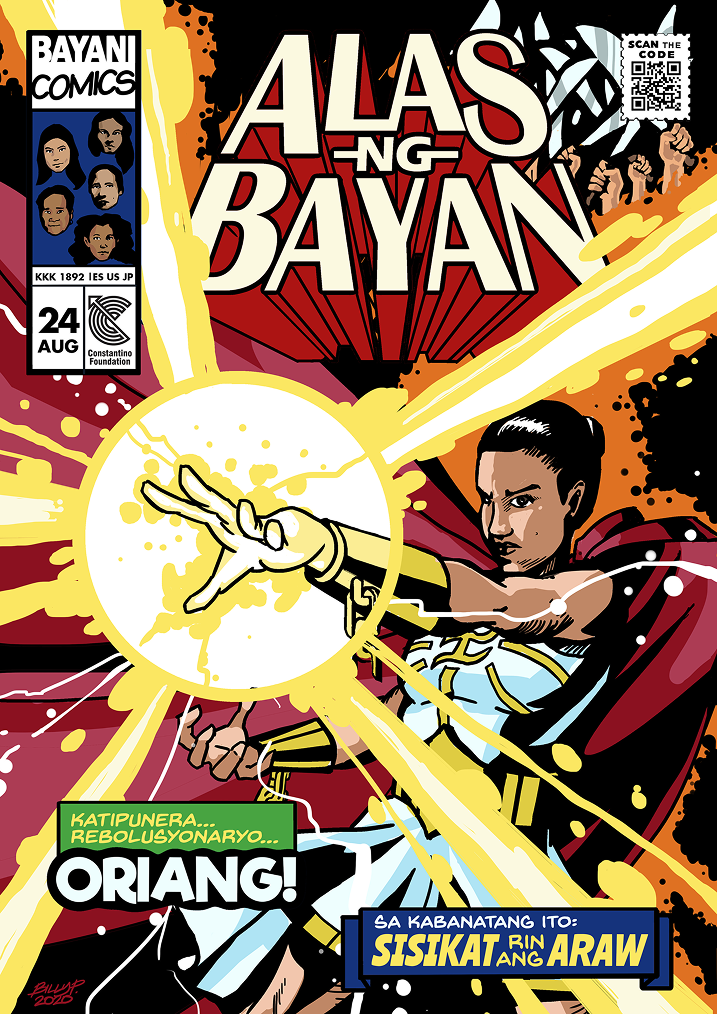
Gregoria de Jesus
Gregoria de Jesus Kilala bilang “Lakambini” ng Katipunan si Oriang, ang asawa ni Andres Bonifacio, ang unang pangulo ng bayan. Naging aktibong kalahok si Oriang sa Himagsikan, mul a sa pagkakatatag ng lihim na samahan hanggang at lampas pa sa Rebolusyon ng 1896. Sabi ni Oriang: “Hindi ako natakot harapin ang panganib, kahit kamatayan, pag kasama ko ang mga Katipunero sa labanan… sa pagnanais na makitang nagwawagayway ang watawat ng malayang Filipinas.” Ang pagwawakas ng karahasan sa kababaihan ay kabilang sa mga pinakamataas na kalatas ng Katipunan.
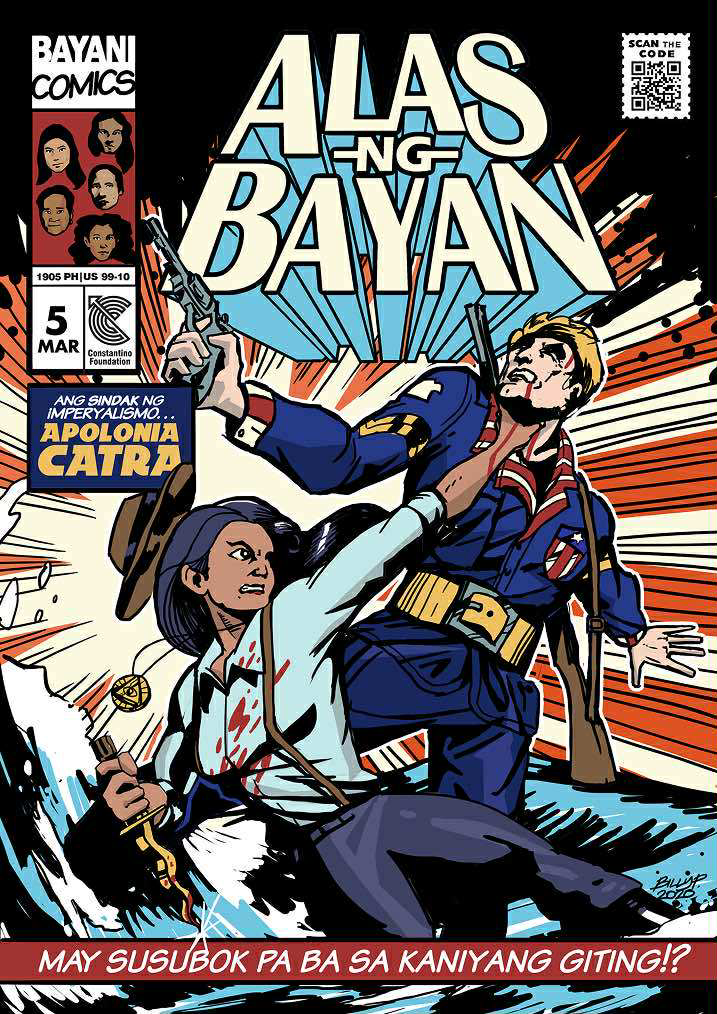
Apolonia Catra
Apolonia Catra Si Apolonia ang tanging babaeng opisyal na napangal anan sa hukbong pinamunuan ni Hen. Macario Sakay, pangulo ng Republika ng Katagalogan. Halos walang nababanggit tungkol kay Catra sa kasaysayan. Wala siyang kilalang larawan at maski araw ng kanyang kapanganakan ay hindi tiyak. Napatay siya sa isang sagupaan noong ika-5 ng Marso 1905 habang pwersahang dinudurog ng Amerika ang ating Republika. Ayon sa Amerikanong iskolar na si George Yarrington Coates, “Damit pang-lalaki ang madalas isuot [ni Catra] at nakilala siya sa kanyang kalupitan at katapangan.”

Remedios Gomez-Paraiso
Remedios Paraiso-Gomez Kilala bil ang “Kumander Liwayway,” naging lider siya ng Hukbo Laban sa mga Hapon o Hukbalahap. Nanguna siya sa maraming sagupaan laban sa pasistang Hapon. Walang takot niyang pinamunuan ang maraming labanan sa Pampanga, Tarlac, at Zambales. Malimit siyang naglalagay muna ng lipstick bago sumabak sa labanan dahil, aniya, nais niyang maging maganda bago pumatay ng kaaway. Nang sumuko ang mga Hapon, tinugis ang mga Huk ng hukbong sandatahan ng Filipinas dal a ng utos ng mga Amerikanong opisyal, kaya’t sumapi siya sa Hukbong Mapagpalaya ng Bayan.

Lorena Barros
Lorena Barros Si Lorena ang naging pinunong tagapagtatag ng Malayang Kilusan ng Bagong Kababaihan o MAKIBAKA. Isang manunul at at makata, anak si Lorena ni Alicia Morelos, na apo ng isang Katipunero at naging kasapi rin ng Hukbalahap. Nagtapos ng antropolohiya sa University of the Philippines noong 1970, nanguna si Lorena sa pakikibakang nagsulong ng pambansang demokrasya. Sumampa siya sa liham na kilusan para labanan ang diktadurya. Nabaril siya sa isang enkwentro sa militar noong 1976.
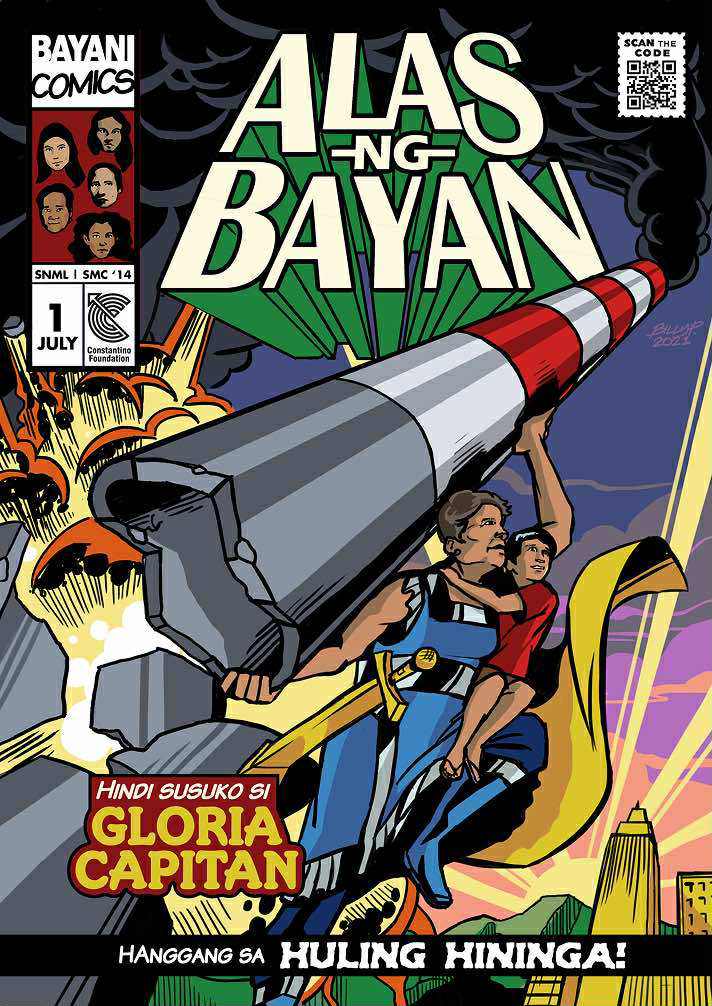
Gloria Capitan
Gloria Capitan Aktibistang lola si Gloria Capitan na kumilos para l abanan ang pagtatayo ngisang dambuhalang coal plant sa kanilang bayan sa Mariveles, Bataan. Kampanyador siya laban sa nagwawal ang klima at kil al a siya sa kanyang lakas ( nagtatayo siya ng mga bahay) at disiplina. Pinaslang sa loob ng kanyang kantina noong ika-1 ng Hulyo 2016, si Gloria ang unang naital ang e x traj udicial killing sa panahon ni Duterte. Sigaw ni Gloria: “ Titigil lang ako ‘pag pikit na ang mata ko ! Hindi ito para sa akin, kundi para sa mga apo ko!”
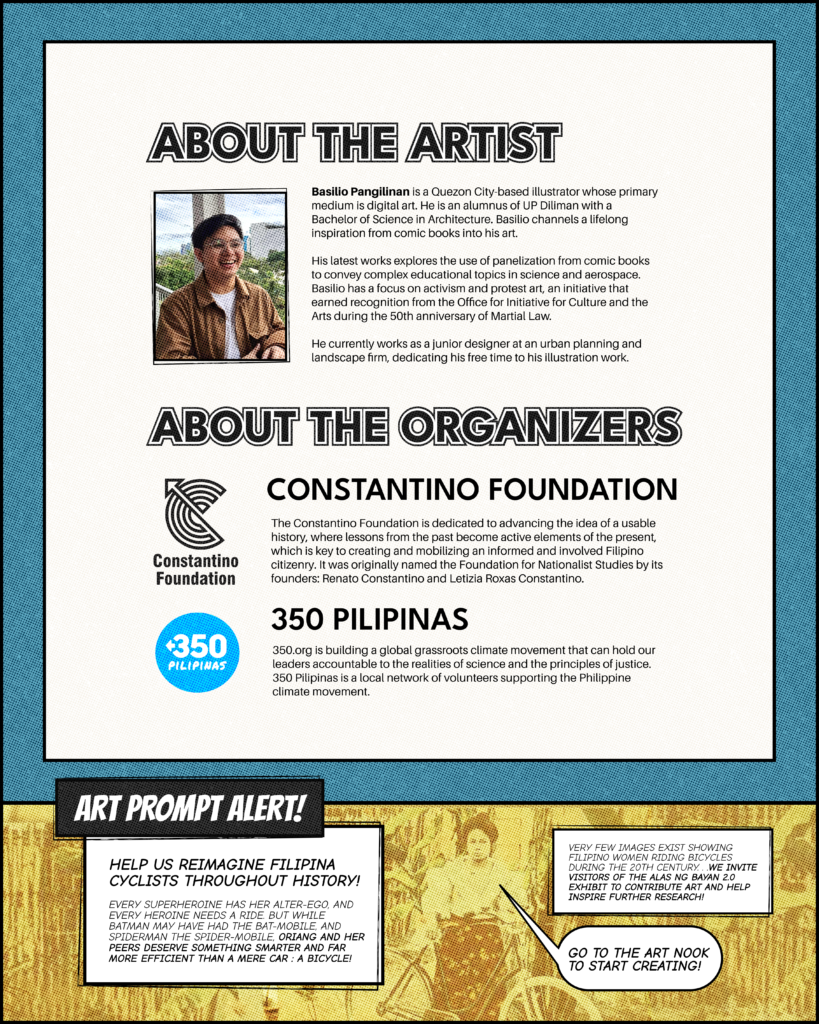
ALAS NG BAYAN 1
Aesthetic Concept: Alas and Five Aces
Alas ng Bayan is about five remarkable Filipinas who resisted national oppression, social injustice, and false gender normatives at different junctures of Philippine history.
As the artworks deal with historical truths and the surreal, the Alas ng Bayan paintings were rendered in the style of Tarot cards or sakla, the card game used often in urban areas, many times in working class neighborhoods and during funeral wakes. Early in its history, the Tarot was used as playing cards by noble families in Italy. It was in the nineteenth-century that the Tarot card was linked to witchcraft and religion. Spiritual and esoteric groups have since considered the Tarot a body of knowledge compromising different archetypal images that cross linguistic, cultural, geographical, and temporal barriers.
Like the Tarot, the Alas ng Bayan paintings mirror similar mysticism while provoking its viewers to engage, if not decode, subtle symbolisms placed throughout the images. Alas is a local word for ace, a card that in most games is ranked as the highest, e.g. the ace of diamonds. It connotes a winning card or a secret advantage, for instance, “an ace up one’s sleeve.” As an adjective, its synonyms are excellent, outstanding, masterly, virtuoso, and first-rate. As a noun, an ace is equivalent to a champion, a doyen, an expert, and a master.
Can a normal card game have five aces? There are only four suits in typical poker games: diamonds, hearts, clubs, and spades. Aces with all four suits in one hand are called cuadro de alas (a winning hand bested only by the rare Royal Flush). Yet the Alas ng Bayan paintings convey a fifth suit, suggesting women and heroism as notions that refuse to be contained by conventional definitions. A quinta de alas suit seems absurd even as a linguistic Creole contrivance. But the framing seems apt; we live in interesting times when more and more young people, especially young women weary of corrosive machismo, refuse to play by the rules, openly choosing to resist and defeat toxic masculinity.
In Latin numerals as well, quinta is the female equivalent of quintus, which translates to “fifth”. Quinta is an anomaly. It’s etymology is linked to quinta essentia which translates as the fifth element and is where the word quintessential comes from. Some discussions link quinta to pre-atomic theory where four “known” elements or essences are identified — Earth, Air, Fire and Water — in addition to a putative fifth element, quinta essentia. The fifth element was believed to be superior to the other elements, and so, “quintessential” has come to mean something that is superior. The fifth element was believed to be more subtle, permeating the fabric of things and was thought to be more difficult to find or to isolate. This is why the word quintessential is used often today to describe the essence of things nearing perfection. In this light, Oriang, Apolonia, Liwayway, Lorena, and Gloria are without any doubt quintessential to Philippine history.
The Paintings
The works of art cover five Filipinas each of whom lived in different historical periods. They have been chosen as subjects as they are a good mix of women across generations, across key periods in our history, across different acts of resistance, and across a range of popularity, meaning, from the well-known to the unknown.
 Gregoria “Oriang” de Jesus
Gregoria “Oriang” de Jesus
Gregoria “Oriang” de Jesus (09 May 1875-15 March 1943) helped organize, grow and mobilize the the revolutionary secret society known as the Kataas-taasan, Kagalang-galangang Katipunan ng mga Anak ng Bayan together with her husband, the great hero Andres Bonifacio. Known as Lakambini, Oriang was deeply involved in the revolutionary war from around the time of the Katipunan’s founding in 1892 until the open uprising of 1896 and beyond. The Katipunan threw off the yoke of Spanish colonialism and gave birth by 1899 to Asia’s first, though short-lived, Republic which, shortly after, was crushed by the boot of US imperialism. Wrote Oriang, “I had no fear of facing danger, not even death itself, whenever I accompanied the soldiers in the battle, impelled as I was then by no other desire than to see unfurled the flag of an independent Philippines, and I was present in and witnessed many encounters. I was considered a soldier, and to be true, I learned how to ride, to shoot a rifle, and to manipulate other weapons … without tasting food for the whole day, to drink dirty water from mud-holes or the sap of vines.” From Oriang’s direct experience and from edicts issued by the Katipunan, the leaders of the Philippine revolution against Spain were pioneers in the way they located violence against women at the center of the struggle for national liberation. Oriang worked closely with Emilio Jacinto and Macario Sakay. Of the latter, she said, “I know that he helped greatly the Katipunan. Macario Sakay was a true patriot.” Oriang was an ordinary person who acted like a giant by advancing the cause of national freedom.
Painting notes
What explains the words in this painting? Did you know that Oriang’s second husband, Julio Nakpil, a national hero, musical composer and one of the most respected leaders of the Katipunan, used “Giliw” as his alias? Oriang’s words are a constant reminder to all about a basic cosmic truth that many often forget: “Fear history, for it respects no secrets.” Behind Oriang is a forest, through which a river flows and which paradoxically appears to come to a full stop. Perhaps it is the artist’s statement concerning the continuities and discontinuities of history and memory? Oriang appears relaxed in the painting while leaning on a red pillow draped with crimson fabric. Yet she holds aloft a saber. Why did the artist place a heart-shaped symbol beneath the hero, and what is the script at its center? What does it mean? Why did the artist paint in the foreground a fence, which provides little obstruction? In her autobiography, Oriang recalls her disposition while helping throw off the colonizer’s yoke: she always took sides. She was no fencesitter, for sure.
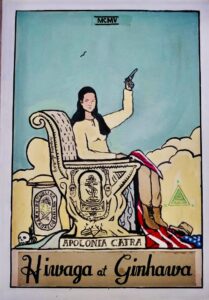 Apolonia Catra
Apolonia Catra
Apolonia Catra (Died: March 05, 1905) is the only named woman officer in the armed forces of General Macario Sakay, President of the Tagalog Republic, under the command of Lt. Col. Lucio de Vega. There is scant mention of her in historical accounts; even her date of birth is unknown. She was killed in combat on March 5, 1905, during the Philippine-American War. Theodore Roosevelt, then the US president, declared the end of Philippine-American hostilities in July 1902 even though the revolutionary war to overthrow foreign occupation raged on over an endless decade. The struggle was led by the likes of Sakay who, through brazen American duplicity, was captured in 1906 and hanged a year later by US troops. Apolonia is one of many historical ciphers in Philippine history: she is the only woman in the Alas ng Bayan series without a known portrait or photo. The artist John Earhard Guarin chose to depict as her likeness a young Nora Aunor. The Washington State newspaper Evening Statesman reported in 1905 that Catra “was surprised in the mountains and refused to surrender.” Like Sakay and others who fought under his leadership, Apolonia was branded a bandit by US authorities. In a 1968 study by the Ohio State University scholar George Yarrington Coats, Apolonia was described in a way that brings to mind current LGBT debates and issues surrounding extrajudicial killings (EJKs): “She dressed in men’s clothing and was well known for her cruelty and reckless courage.” High praise coming from a US academic.
Painting notes
What might be behind the title of the painting? Can you recognize the symbols on Apolonia Catra’s chair? What does it mean? Is it an amulet? Who might have worn it? Why is there a name on the back rest? Whose name is it? What might explain the lone bird painted in the horizon? What is the real story behind the seemingly ‘regionalistic’ emblem behind Apolonia? Questions abound.
No photos exist to indicate what Apolonia Catra might have looked like. Why did the artist use a young Nora Aunor as his model? Do you agree with his choice? Who else should he have considered as his peg? If you had painted Apolonia, what elements would you have integrated based on George Yarrington Coats description of her in his unpublished thesis on the Philippine Constabulary? Why do think there is so little material about women heroes in our country’s history? Gregoria de Jesus once said: “Remember always the sacred teachings of our heroes who sacrificed their lives for love of country.” How would you choose to remember Apolonia Catra?
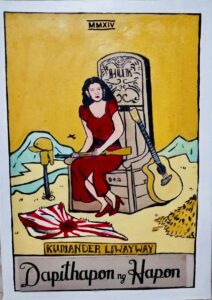 Remedios Gomez-Paraiso
Remedios Gomez-Paraiso
Remedios Gomez-Paraiso (July 12 1918-May 15, 2014) was a guerilla who fought the Japanese occupation of the Philippines during World War II under the alias Kumander Liwayway. She was an officer of the Hukbong Bayan laban sa Hapon or Hukbalahap. Kumander Liwayway was a fearless Filipina known for riding headlong into battle astride a horse, pistol in hand and wearing red lipstick. She led divisions spanning Pampanga, Tarlac, and Zambales and was one of the most trusted officers of Huk Supremo Luis Taruc. Liwayway believed she would return to civilian life after the defeat of the Japanese fascist forces. But the Cold War had just begun. Under instructions from US officers, the Philippine Constabulary hunted down Huk forces with murderous zeal and Liwayway was once more forced to fight from the mountains, this time as an officer of the Hukbong Mapagpalaya ng Bayan (HMB) of the Partido Komunista ng Pilipinas (PKP-1938). The journalist Tonette Orejas quotes Paraiso saying, “One of the things I am fighting for in the Huk movement is the right to be myself,” in response to comrades who criticized her for wearing makeup and appearing feminine. Liwayway brought up her grandchildren and great grandchildren, who affectionately called her “Mommy” and “Mommylola” respectively.
Painting notes
What is the strange headgear on top of the stick by the side of the hero? What does it symbolize? What explains the lone bird in the horizon? What explains the presence of a guitar in the painting? The carving at the back of Kumander Liwayway is the artist’s way of showing the craftsmanship of Pampanga. Even though, at great cost, they helped repulse the imperial forces of Japan, Remedios Gomez-Paraiso and her comrades were hunted down and forced again to fight from the mountains soon after Japan’s surrender. Why? What new cause did Kumander Liwayway come to champion, and how did the term “Huk” evolve? The fierce courage of Kumander Liwayway during wartime was well known. She was feared by Japanese soldiers and the Philippine armed forces. Yet few know the extent to which she was also intensely embraced by her loved ones, judging by the way her children, grandchildren, and great grandchildren, received her motherly affection and the incredible caring she showered on her family.
 Maria Lorena Barros
Maria Lorena Barros
Maria Lorena Barros (March 18, 1948-March 24, 1976) was the founding chair of Malayang Kilusan ng Bagong Kababaihan or MAKIBAKA. Laurie, as her mother called her, went underground soon after the declaration of Martial Law. She was a writer and a student of history, a daughter, wife, and mother, a warrior and a poet. The Bantayog ng mga Bayani writes, “[f]rom early childhood, Barros showed keen intelligence, a searching mind and precocious social awareness, nurtured by her mother Alicia Morelos. The latter, granddaughter of a Katipunero and herself a member of the Hukbalahap guerrilla resistance, would become her daughter’s closest friend and confidant.” Laurie graduated from the University of the Philippines in 1970 with a degree in anthropology. “[S]he was someone who refused to be confined to the stereotypical image of a student activist, or a feminist activist. She did not repress her natural charm and kindheartedness.” As an activist determined to advance the cause of national democracy while resisting military rule and the illegitimate Marcos government, Laurie joined the underground to fight the tyrannical dictatorship. In March 1976, she “was seriously wounded in an armed encounter with soldiers in … Mauban, Quezon… Medical treatment was promised by her captors if she would cooperate with them, but she said she would rather die for her beliefs. She was shot in the nape. She was 28 years old.”
Painting notes
What explains the title of this painting? Can you identify the four circular logos surrounding Lorena? Why do you think the artist chose white as the color of the hero’s toga, and what might the symbols in the fabric mean? What do fruits, or grapes, in Tarot symbolism represent? What does the mountain behind the Oblation stand for? Questions abound. Find out more about the rich, haunting, inspiring and textured life of Lorena Barros from the book by Pauline Mari Hernando, Lorena: Isang Tulambuhay, published by the University of the Philippines Press.
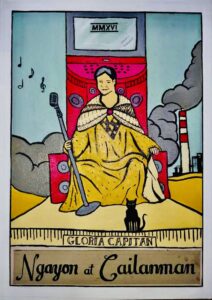 Gloria Capitan
Gloria Capitan
Gloria Capitan (March 28, 1959-July 1, 2016) was an anti-coal activist and human rights defender affiliated with the Coal-Free Bataan Movement. She was a former president of the Samahan ng Nagkakaisang Mamamayan ng Lucanin, a community-based organization that campaigned actively against the development of a coal plant and open coal storage facility in Barangay Lucanin, Mariveles, Bataan. Known for her physical strength and mental discipline, she would construct wooden houses using her own hands. She was known throughout her community as a fierce yet caring, fearless and hands-on leader ready to call out and resist environmental and social injustice. She was a woman made powerful by her conviction and obstinate refusal to accept a future devastated by dirty energy and greedy corporations. Gloria was assassinated in her own videoke cantina by two unidentified gunmen on July 01, 2016, the very day President Duterte was sworn into office. Her death was the first recorded extrajudicial killing under the Duterte administration. Gloria was known for her fortitude against adversity. She received many threats, but nonetheless continued to actively participate in and lead campaigns up to the time of her death. As she used to say, “Titigil lang ako ‘pag pikit na ang mata ko! Ano pa ba ang magagawa ko e patay na ako. Hindi ito para sa akin, kundi para sa mga apo ko, masakit ang loob ko kapag nakikita ko silang nagkakasakit”.
Painting notes
Do you recognise the machine behind Gloria Capitan? What is the facility billowing filthy smoke behind the hero? The black cat in the foreground seems to pay homage to Théophile Steinlen’s 1896 poster for an entertainment establishment in the bohemian district of Montmartre in Paris, the Le Chat Noir. What explains the title of the painting, and why is it spelled differently?
The Artist

John Erhard P. Guarin (24 July 1993) is a Filipino painter, poet, and hip-hop recording artist from Tondo, Manila. He pursued a Bachelor’s Degree of Fine Arts in Visual Communication in Eulogio Amang Rodriguez Institute of Science and Technology (EARIST). He began painting at the age of 13 in the streets of Manila. By the age of 24, he started volunteering as an artist for 350.org. It was not until 2017 that he accepted commissions to create art for different religious networks and organizations. From there, he began to develop his career as a professional painter, crafting his works using mainly oil on canvas.
𝐀𝐥𝐚𝐬 𝐧𝐠 𝐁𝐚𝐲𝐚𝐧 𝟐.𝟎 𝐎𝐩𝐞𝐧𝐬 𝐓𝐨𝐦𝐨𝐫𝐫𝐨𝐰 𝐚𝐭 𝐏𝐔𝐏 𝐒𝐭𝐚. 𝐌𝐞𝐬𝐚
The Constantino Foundation, in partnership with the Polytechnic University of the Philippines (Official), PUP Department of History PUP Samahan ng mga Mag-aaral ng Kasaysayan , and the 350 Pilipinas proudly presents Alas ng Bayan 2.0:[READ]
LAKAMBINI: When History Refuses to Stay Silent, by Cardinal Pablo Virgilo David (on a movie the Constantino Foundation encourages you to watch).
I must confess, when I sat down to watch Lakambini, I thought I was merely revisiting a historical figure I already admired — Gregoria de Jesús, the Lakambini ng Katipunan, wife of the Supremo. But[READ]
HEROES IMMORTALIZED – Manila Times
People visit a comic art exhibit featuring Filipinas who transform into powerful modern-day superheroes. Dubbed 'Alas ng Bayan 2.0,' the stories reinterpret the legacy of Filipina resistance—from the 19th century to the present. The free[READ]
Alas ng Bayan 2.0 Opening
𝐀𝐥𝐚𝐬 𝐧𝐠 𝐁𝐚𝐲𝐚𝐧 𝟐.𝟎 𝐄𝐱𝐡𝐢𝐛𝐢𝐭 𝐎𝐩𝐞𝐧𝐢𝐧𝐠 📍 Tandang Sora Women’s Museum | October 15, 2025 📸 Photos by Bernard Testa A powerful launch honoring the unbroken line of Filipina heroism—from Gregoria de Jesus, Apolonia[READ]
“Hindi krimen ang maging makabayan.” – Judy Taguiwalo
Mensahe sa Pasinaya sa Exhibit ng Alas ng Bayan 2. O Tandang Sora Women’s Museum Oktubre 15, 2025 Makasaysayan ang buwan ng Oktubre sa maraming dahilan. Para sa akin dalawa ang may katuturan sa hapong[READ]
ATM: Opisyal nang binuksan sa publiko ang “Alas ng Bayan 2.0” sa Tandang Sora Women’s Museum! – Bandera
ATM: Opisyal nang binuksan sa publiko ang “Alas ng Bayan 2.0” sa Tandang Sora Women’s Museum!Present sa launch ang mga opisyal ng QC at mga kaanak ng mga kilalang Pinay icons na sina Gregoria “Lakambini”[READ]

